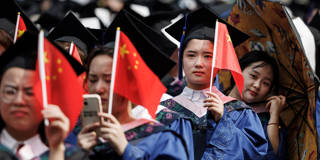For decades, China’s growth has followed the pattern of advanced economies, with rising incomes and educational attainment, shrinking family size, and growing female labor-force participation. But across these and other dimensions, the economy now appears to be going backward.
CHICAGO – In May, China reported that youth unemployment (among those aged 16 to 24) had reached a record-breaking 20.8%, with the high-paying, high-skilled jobs that university graduates are trained for growing scarcer. Since mid-2021, hundreds of thousands of positions have been eliminated in the tech sector, owing to the COVID-19 pandemic, stringent capital and antitrust regulations, and the government’s broader “tech crackdown.” And, as the rapidly changing policy environment adds to the uncertainty, cutbacks are also coming to other high-skilled sectors like finance.
In June, the Chinese internet was flooded with despairing photos and messages from new graduates whose only employment prospects lay in low-paying sectors, where there is still some job growth. Chinese students and their parents are finding this new economic reality difficult to accept, given the tremendous sacrifices they made for higher education.
The Chinese education system is one of the most competitive in the world, not least because college admission is determined by a single standardized national exam, the gaokao. By the time most graduates from good colleges arrive on the job market, they have committed many years of their youth to intensive study. The pressure to master the core curriculum – math, science, and literature – is so great that even elementary schools have cut back on non-academic classes such as physical education and music.

CHICAGO – In May, China reported that youth unemployment (among those aged 16 to 24) had reached a record-breaking 20.8%, with the high-paying, high-skilled jobs that university graduates are trained for growing scarcer. Since mid-2021, hundreds of thousands of positions have been eliminated in the tech sector, owing to the COVID-19 pandemic, stringent capital and antitrust regulations, and the government’s broader “tech crackdown.” And, as the rapidly changing policy environment adds to the uncertainty, cutbacks are also coming to other high-skilled sectors like finance.
In June, the Chinese internet was flooded with despairing photos and messages from new graduates whose only employment prospects lay in low-paying sectors, where there is still some job growth. Chinese students and their parents are finding this new economic reality difficult to accept, given the tremendous sacrifices they made for higher education.
The Chinese education system is one of the most competitive in the world, not least because college admission is determined by a single standardized national exam, the gaokao. By the time most graduates from good colleges arrive on the job market, they have committed many years of their youth to intensive study. The pressure to master the core curriculum – math, science, and literature – is so great that even elementary schools have cut back on non-academic classes such as physical education and music.